belt SSANGYONG NEW ACTYON SPORTS 2013 Owner's Manual
[x] Cancel search | Manufacturer: SSANGYONG, Model Year: 2013, Model line: NEW ACTYON SPORTS, Model: SSANGYONG NEW ACTYON SPORTS 2013Pages: 751, PDF Size: 72.63 MB
Page 643 of 751
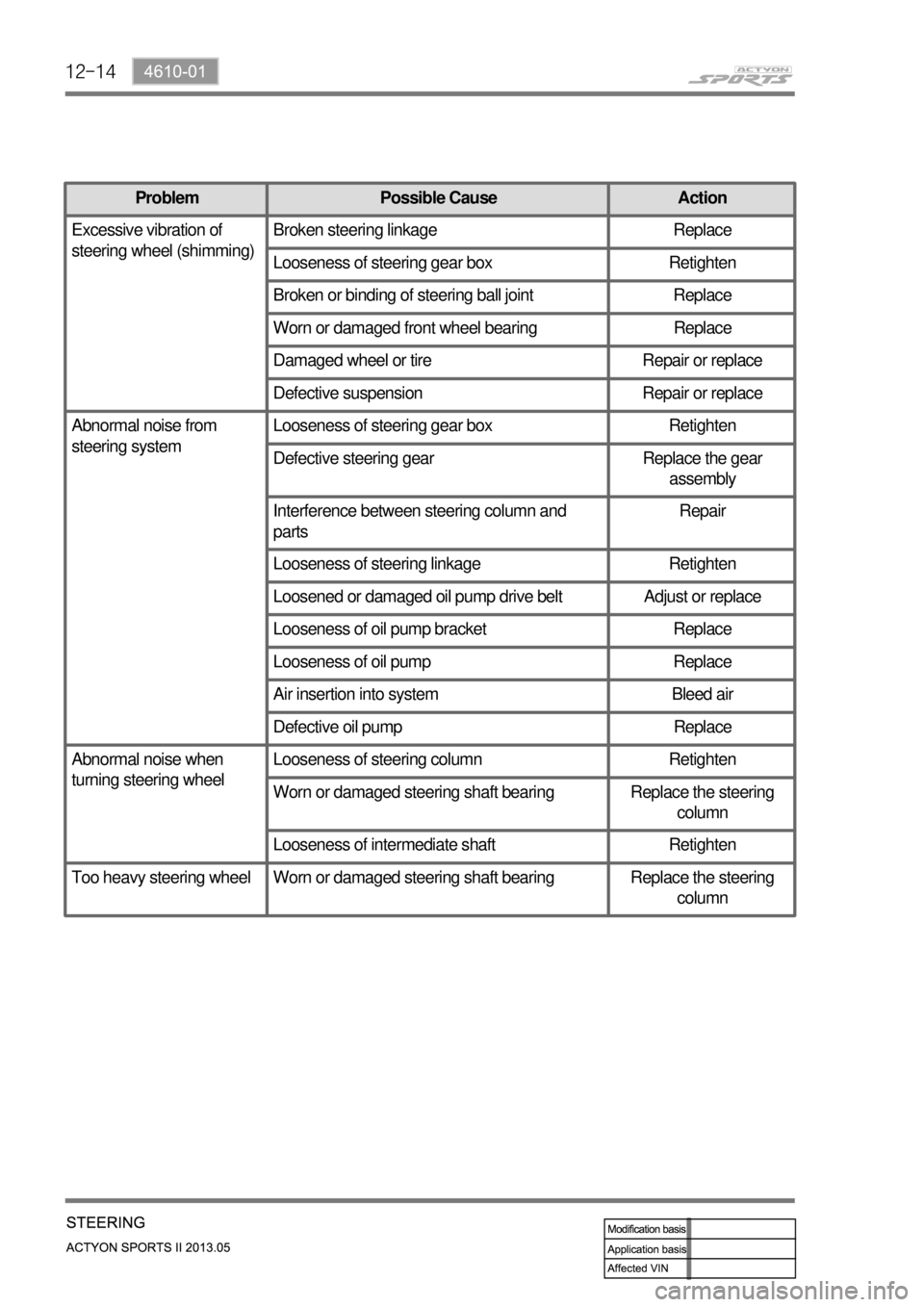
12-14
Problem Possible Cause Action
Excessive vibration of
steering wheel (shimming)Broken steering linkage Replace
Looseness of steering gear box Retighten
Broken or binding of steering ball joint Replace
Worn or damaged front wheel bearing Replace
Damaged wheel or tire Repair or replace
Defective suspension Repair or replace
Abnormal noise from
steering systemLooseness of steering gear box Retighten
Defective steering gear Replace the gear
assembly
Interference between steering column and
partsRepair
Looseness of steering linkage Retighten
Loosened or damaged oil pump drive belt Adjust or replace
Looseness of oil pump bracket Replace
Looseness of oil pump Replace
Air insertion into system Bleed air
Defective oil pump Replace
Abnormal noise when
turning steering wheelLooseness of steering column Retighten
Worn or damaged steering shaft bearing Replace the steering
column
Looseness of intermediate shaft Retighten
Too heavy steering wheel Worn or damaged steering shaft bearing Replace the steering
column
Page 648 of 751
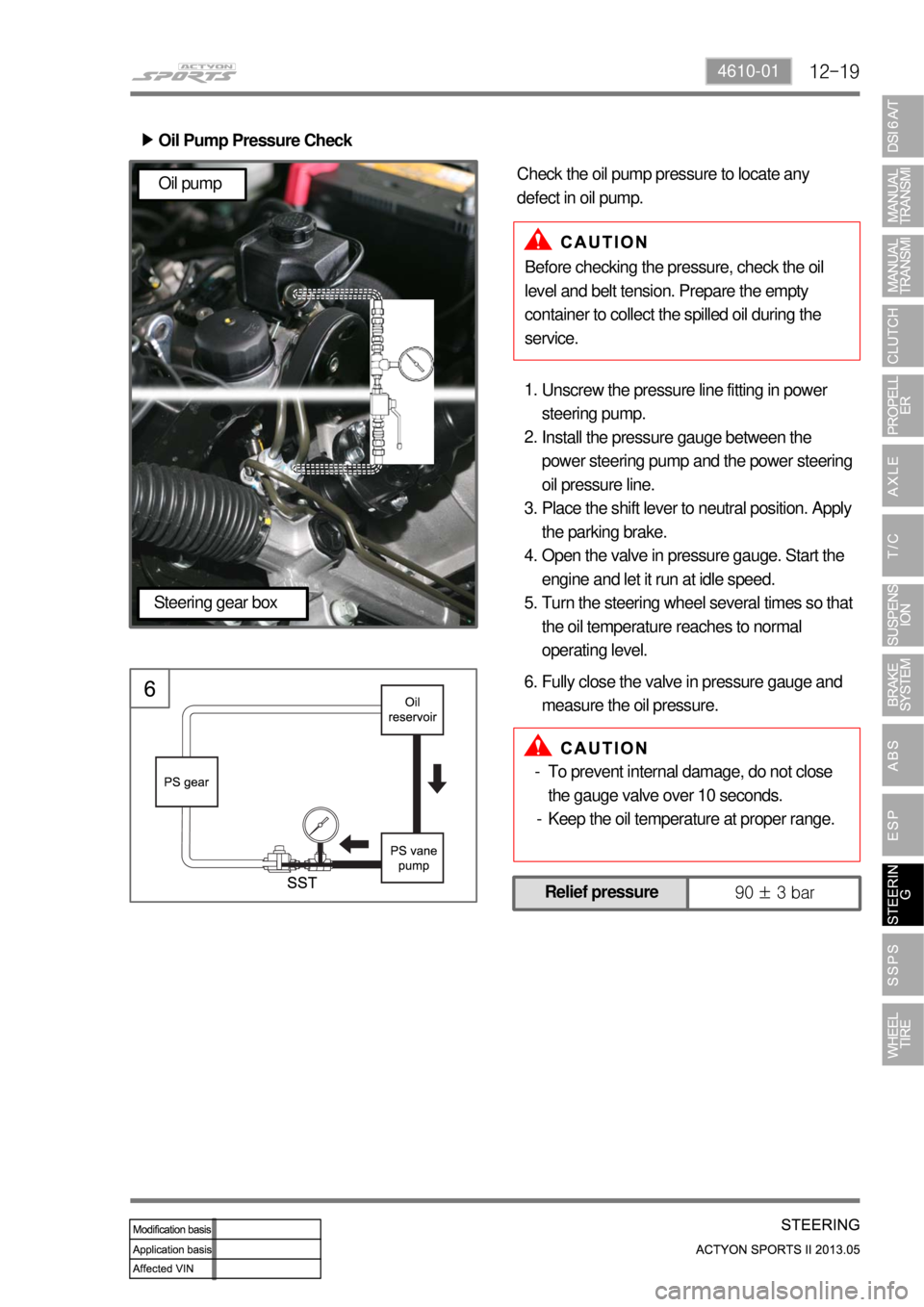
12-194610-01
Oil Pump Pressure Check ▶
Unscrew the pressure line fitting in power
steering pump.
Install the pressure gauge between the
power steering pump and the power steering
oil pressure line.
Place the shift lever to neutral position. Apply
the parking brake.
Open the valve in pressure gauge. Start the
engine and let it run at idle speed.
Turn the steering wheel several times so that
the oil temperature reaches to normal
operating level. 1.
2.
3.
4.
5.
Before checking the pressure, check the oil
level and belt tension. Prepare the empty
container to collect the spilled oil during the
service. Check the oil pump pressure to locate any
defect in oil pump.
Fully close the valve in pressure gauge and
measure the oil pressure. 6.
Relief pressure
90 ± 3 bar
Oil pump
Steering gear box
To prevent internal damage, do not close
the gauge valve over 10 seconds.
Keep the oil temperature at proper range. -
-
Page 651 of 751

12-22
2. SYSTEM LAYOUT
The steering pump is driven by the engine power through a belt. This pump circulates the power steering
oil from the reservoir -> steering pump -> oil supply pipe -> steering gear box -> oil return pipe ->
reservoir to perform steering operations
Return hose & tube
Steering pump &
reservoir
High pressure hose
Linkage gear box Steering wheel
Lower shaft Column & shaft
Return hose & tube
Steering pump &
reservoir
High pressure hose
Linkage gear box Steering wheel
Lower shaft Column & shaft
HPS model
SSPS model
Page 672 of 751
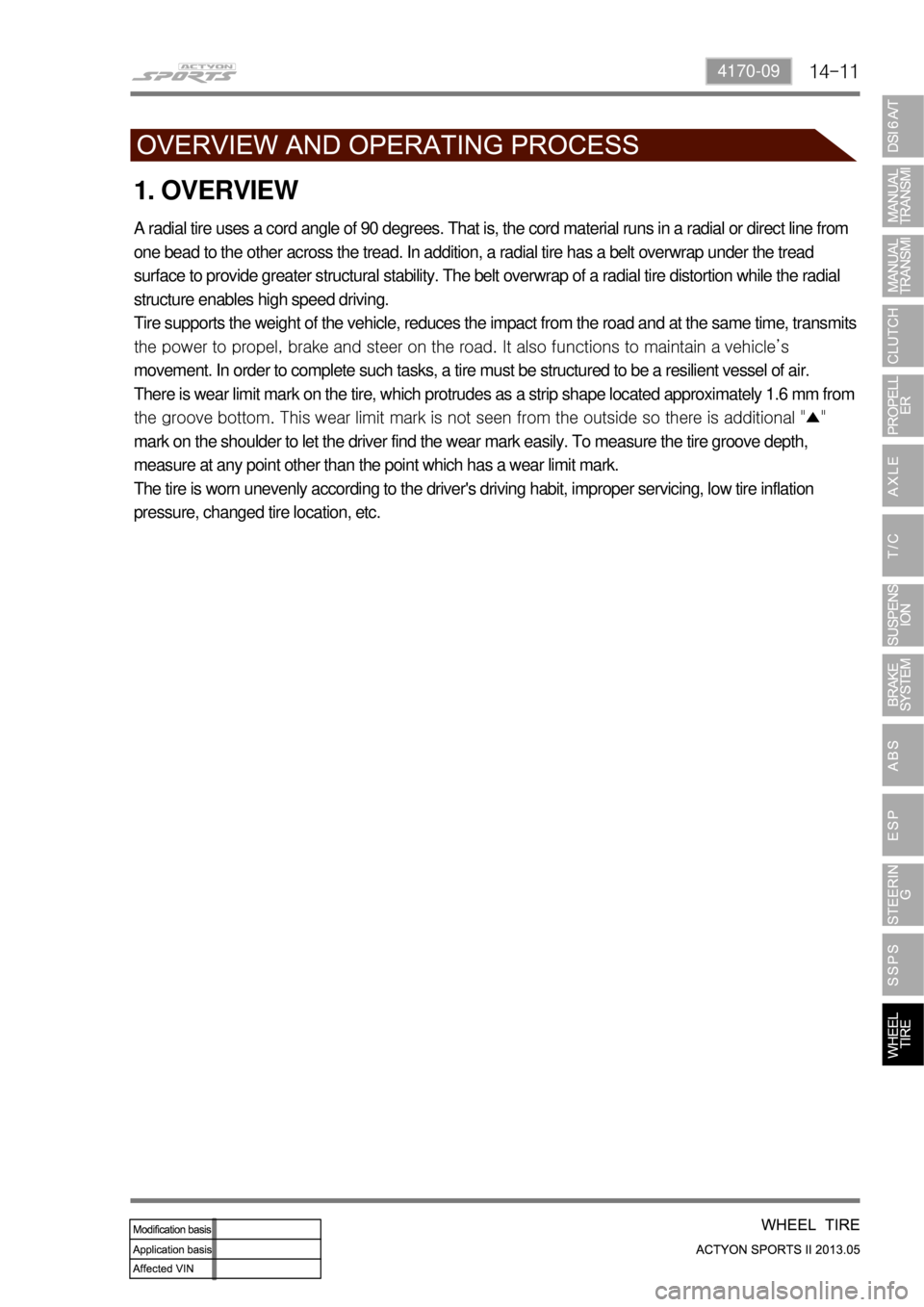
14-114170-09
1. OVERVIEW
A radial tire uses a cord angle of 90 degrees. That is, the cord material runs in a radial or direct line from
one bead to the other across the tread. In addition, a radial tire has a belt overwrap under the tread
surface to provide greater structural stability. The belt overwrap of a radial tire distortion while the radial
structure enables high speed driving.
Tire supports the weight of the vehicle, reduces the impact from the road and at the same time, transmits
<009b008f008c004700970096009e008c00990047009b009600470097009900960097008c0093005300470089009900880092008c004700880095008b0047009a009b008c008c00990047009600950047009b008f008c0047009900960088008b0055004700
70009b004700880093009a00960047008d009c0095008a009b>ions to maintain a vehicle’s
movement. In order to complete such tasks, a tire must be structured to be a resilient vessel of air.
There is wear limit mark on the tire, which protrudes as a strip shape located approximately 1.6 mm from
the groove bottom. This wear limit mark is not seen from the outside so there is additional "▲"
mark on the shoulder to let the driver find the wear mark easily. To measure the tire groove depth,
measure at any point other than the point which has a wear limit mark.
The tire is worn unevenly according to the driver's driving habit, improper servicing, low tire inflation
pressure, changed tire location, etc.
Page 674 of 751
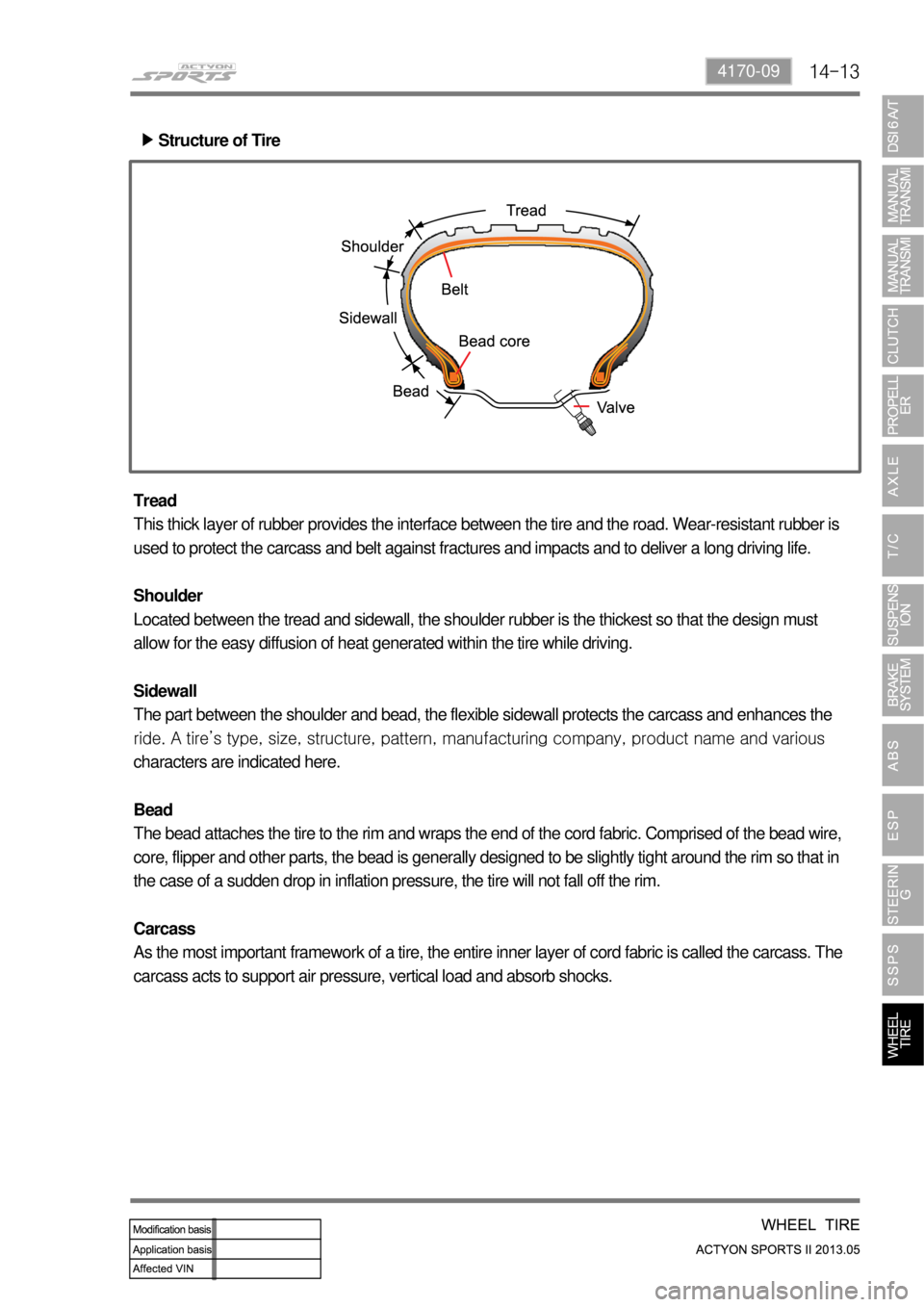
14-134170-09
Structure of Tire ▶
Tread
This thick layer of rubber provides the interface between the tire and the road. Wear-resistant rubber is
used to protect the carcass and belt against fractures and impacts and to deliver a long driving life.
Shoulder
Located between the tread and sidewall, the shoulder rubber is the thickest so that the design must
allow for the easy diffusion of heat generated within the tire while driving.
Sidewall
The part between the shoulder and bead, the flexible sidewall protects the carcass and enhances the
<00990090008b008c0055004700680047009b00900099008c02c5009a0047009b00a00097008c00530047009a009000a1008c00530047009a009b0099009c008a009b009c0099008c0053004700970088009b009b008c009900950053004700940088009500
9c008d0088008a009b009c009900900095008e0047008a0096>mpany, product name and various
characters are indicated here.
Bead
The bead attaches the tire to the rim and wraps the end of the cord fabric. Comprised of the bead wire,
core, flipper and other parts, the bead is generally designed to be slightly tight around the rim so that in
the case of a sudden drop in inflation pressure, the tire will not fall off the rim.
Carcass
As the most important framework of a tire, the entire inner layer of cord fabric is called the carcass. The
carcass acts to support air pressure, vertical load and absorb shocks.
Page 712 of 751

02-38810-01
1. CAUTIONS FOR AIR BAG OPERATION
When there is any deployed air bag (including seat belt pretensioner), the air bag unit should be
replaced. Any DTC (Diagnostic Trouble Code) in the air bag unit should not be cleared since the
unit has data for status when the air bag was deployed as well as information related to the air bag
deployment.
Note that the used components related to the air bag, especially the air bag unit, should be
packaged in an air tight container to prevent any damage.
Do not connect a tester to any connector or component to check supply voltage or resistance of ai
r
bag related components. The detonator may explode due to a sudden extra power supplied by the
tester.
Before removing or installing any air bag related components, disconnect the negative battery
cable. 1.
2.
3.
4.
Collision sensors, a kind of impact G (acceleration) sensor, detect the lateral and longitudinal collisions
and determine whether or not to deploy air bags. The roles of each collision sensor are as follows:
Front G sensors (inside the air bag unit)
Send signals to the front air bags (driver and passenger air bags) and the driver's and front
passenger's seat belt pretensioners. When the front collision G sensor sends out only the air bag
deployment signal, the signal deploys the two front air bags and activates their seat belt
pretensioners.
Once an air bag deploys, its repair parts vary according to the deployment situation and damage to the
vehicle from collision. Needed repairs also slightly vary between the front air bags and the curtain air
bags. The following are the differences:
Replacement parts when the front air bags deploy:
Air bag unit and its wiring (including connector), seat belt pretensioner and its wiring (including
connector), whole front air bags, instrument panel (IP)
Page 713 of 751

02-4
2. OPERATING RANGE
In the event of the collision, the air bag will be deployed when the G value detected by the G
sensor in the SDM is beyond the impact limit. ▶
Seat Belt Status Air Bag OperationSeat Belt Pretensioner Operation
Fastened Over reference speed Below reference speed
Unfastened Below reference speed Inoperative
Failure, during initial
diagnosisBelow reference speed Below reference speed
No sensor Below reference speed Below reference speed
This is based on frontal collision and reference speed is between approx. 4 and 24 km/h. *
The air bag is deployed in the event of frontal collisions while drving.
But, there are exceptional cases as follows: ▶
Situation Condition
May operate or not
Never operate
Seldom oeprate
Underbody impact from the road surface, impact against the curb at a
very high speed, or dropping impact onto the road surface with a
large angle occurs.
The vehicle rolls over or tips over sideward by severe impact. -
-
A collision with oblique impact to the front seat direction or a front collision
to the diagonal direction occurs.
A front/rear collision occurs.
The vehicle rolls over or tips over sideward with minor impact.
The air bag warning lamp is on. -
-
-
-The vehicle is stationary or a front collision occurs with low speed.
A rear collision occurs.
A minor collision occurs. -
-
-
Page 714 of 751
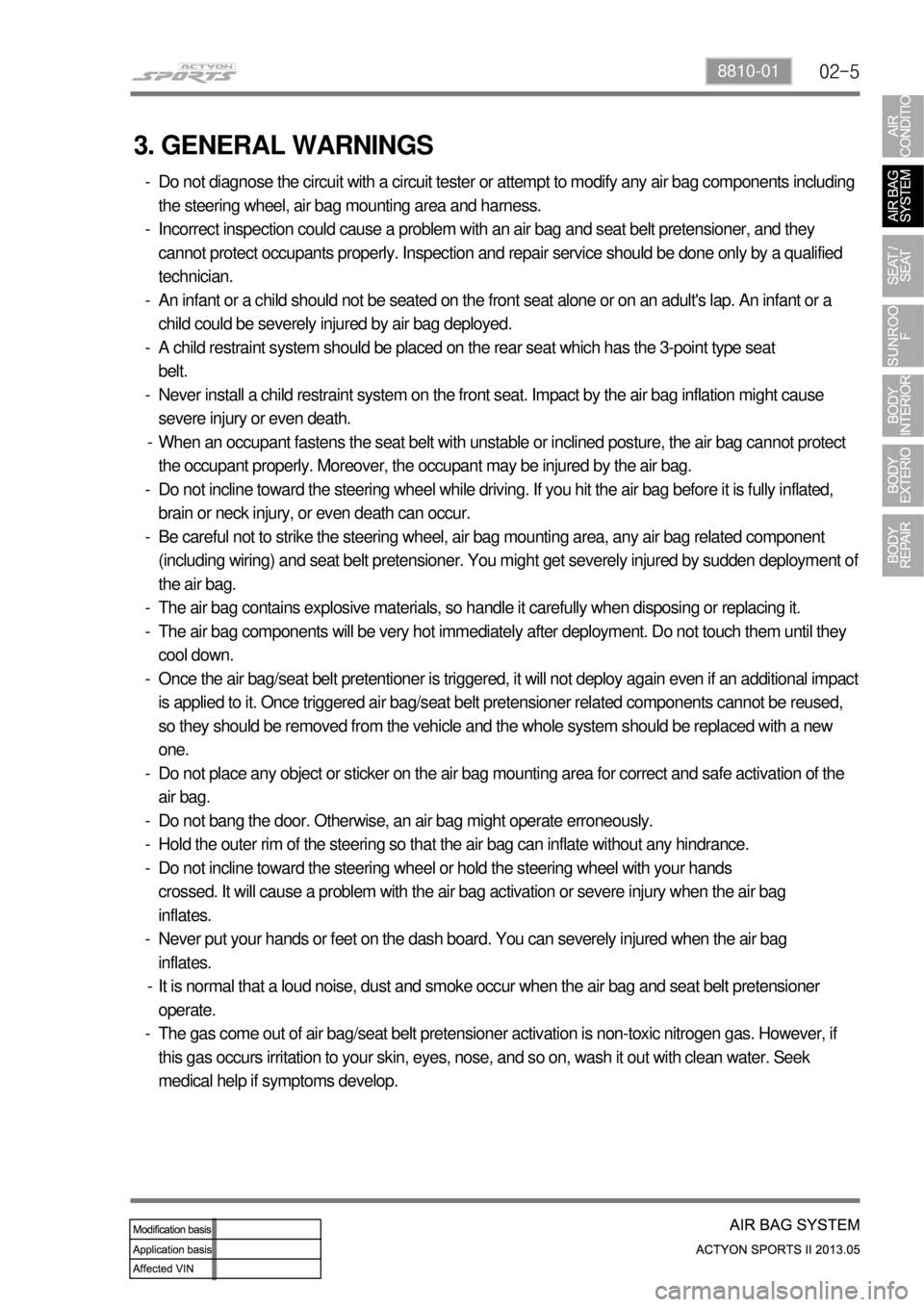
02-58810-01
3. GENERAL WARNINGS
Do not diagnose the circuit with a circuit tester or attempt to modify any air bag components including
the steering wheel, air bag mounting area and harness.
Incorrect inspection could cause a problem with an air bag and seat belt pretensioner, and they
cannot protect occupants properly. Inspection and repair service should be done only by a qualified
technician.
An infant or a child should not be seated on the front seat alone or on an adult's lap. An infant or a
child could be severely injured by air bag deployed.
A child restraint system should be placed on the rear seat which has the 3-point type seat
belt.
Never install a child restraint system on the front seat. Impact by the air bag inflation might cause
severe injury or even death.
When an occupant fastens the seat belt with unstable or inclined posture, the air bag cannot protect
the occupant properly. Moreover, the occupant may be injured by the air bag.
Do not incline toward the steering wheel while driving. If you hit the air bag before it is fully inflated,
brain or neck injury, or even death can occur.
Be careful not to strike the steering wheel, air bag mounting area, any air bag related component
(including wiring) and seat belt pretensioner. You might get severely injured by sudden deployment o
f
the air bag.
The air bag contains explosive materials, so handle it carefully when disposing or replacing it.
The air bag components will be very hot immediately after deployment. Do not touch them until they
cool down.
Once the air bag/seat belt pretentioner is triggered, it will not deploy again even if an additional impac
t
is applied to it. Once triggered air bag/seat belt pretensioner related components cannot be reused,
so they should be removed from the vehicle and the whole system should be replaced with a new
one.
Do not place any object or sticker on the air bag mounting area for correct and safe activation of the
air bag.
Do not bang the door. Otherwise, an air bag might operate erroneously.
Hold the outer rim of the steering so that the air bag can inflate without any hindrance.
Do not incline toward the steering wheel or hold the steering wheel with your hands
crossed. It will cause a problem with the air bag activation or severe injury when the air bag
inflates.
Never put your hands or feet on the dash board. You can severely injured when the air bag
inflates.
It is normal that a loud noise, dust and smoke occur when the air bag and seat belt pretensioner
operate.
The gas come out of air bag/seat belt pretensioner activation is non-toxic nitrogen gas. However, if
this gas occurs irritation to your skin, eyes, nose, and so on, wash it out with clean water. Seek
medical help if symptoms develop. -
-
-
-
-
-
-
-
-
-
-
-
-
-
-
-
-
-
Page 715 of 751

02-6
The windshield or windows can be broken due to impact from driver or passenger air bag
inflation.
When any repairs are needed to the air bag mounting area or its surrounding area, or when an
accident has occurred without the air bag deployment, have the air bag system/seat belt
pretensioner checked for safety.
The air bag is a unit to save an occupant's life from sudden accident and it inflates at a very fast
speed by gas with high temperature, which might cause injury, such as an abrasion, bruise and
burn depending on the accident conditions.
Normal inflation of the air bag could make a loud noise and smoke (non-toxic gas).
A minor collision, which occupants can be protected only by seat belts, will not activate the air bag
system. It is because that air bag inflation at a minor collision could cause more injury such as an
abrasion, bruise and burn.
Check the air bag system even though there is no fault in the air bag system when 10 years have
passed after air bag installation. -
-
-
-
-
-
Page 717 of 751
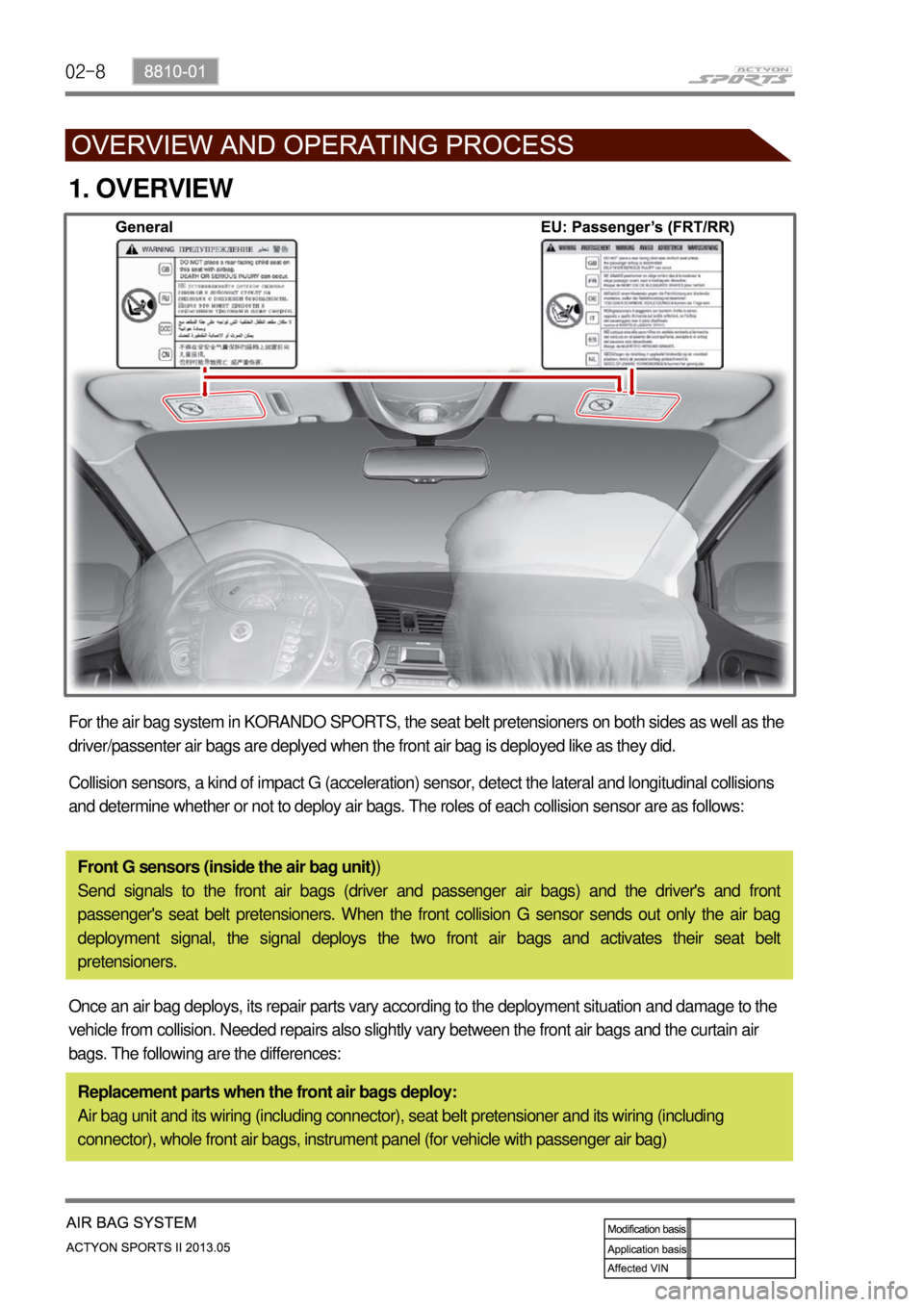
02-8
1. OVERVIEW
Collision sensors, a kind of impact G (acceleration) sensor, detect the lateral and longitudinal collisions
and determine whether or not to deploy air bags. The roles of each collision sensor are as follows:
Front G sensors (inside the air bag unit))
Send signals to the front air bags (driver and passenger air bags) and the driver's and front
passenger's seat belt pretensioners. When the front collision G sensor sends out only the air bag
deployment signal, the signal deploys the two front air bags and activates their seat belt
pretensioners.
Once an air bag deploys, its repair parts vary according to the deployment situation and damage to the
vehicle from collision. Needed repairs also slightly vary between the front air bags and the curtain air
bags. The following are the differences:
Replacement parts when the front air bags deploy:
Air bag unit and its wiring (including connector), seat belt pretensioner and its wiring (including
connector), whole front air bags, instrument panel (for vehicle with passenger air bag) For the air bag system in KORANDO SPORTS, the seat belt pretensioners on both sides as well as the
driver/passenter air bags are deplyed when the front air bag is deployed like as they did.